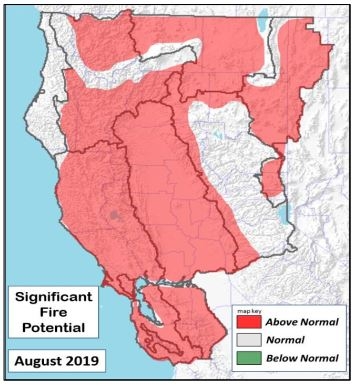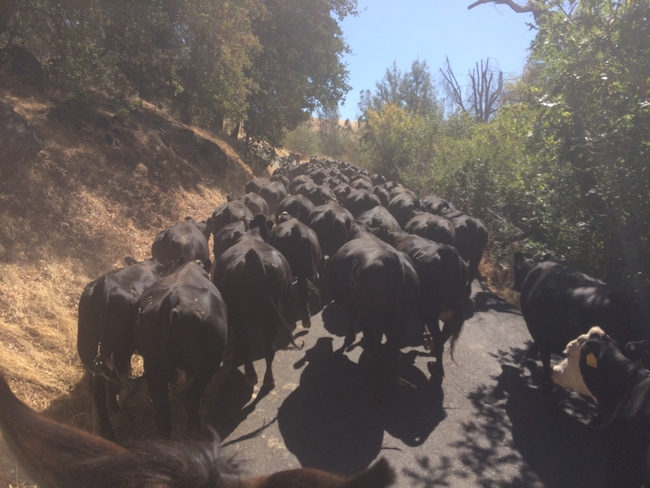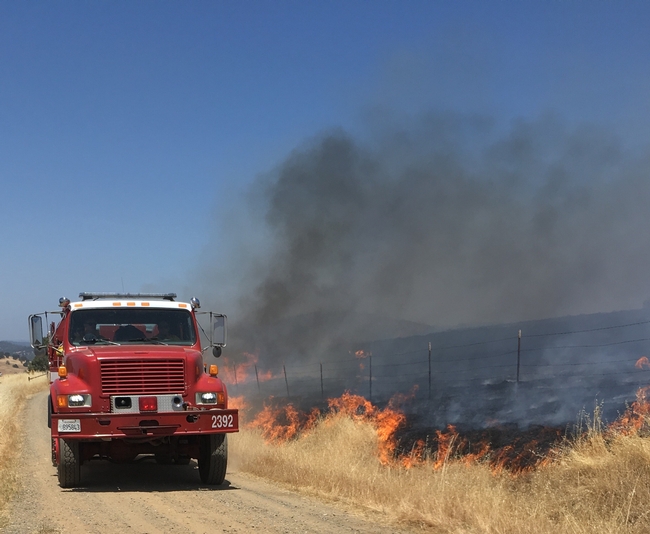For many of us in Northern California, the 2017 and 2018 wildfire seasons are still very fresh in our minds. The late-season fires in Sonoma County in 2017, and the Camp Fire in Butte County in 2018, were among the most destructive deadliest fires in California's history. With above average precipitation - and above average forage growth - ranchers in the Sierra foothills and Sacramento Valley should start working now to prepare for what promises to be another very challenging fire season.

- Near normal temperatures and precipitation through August.
- Above normal snow pack gradually melting through July.
- Weak El Niño continuing through the summer.
- Heavy fine fuel crop [grass!], completely cured in June. Above normal brush growth.
- Below normal amount of summer lightning due to prevailing SW-W flow.
- Normal Significant Fire Potential in May. Above Normal at lower elevations from Sacramento Valley June-August, spreading north and including middle elevations beginning in August. Significant Fire Potential remaining quiet at high elevations.
While many of us have remarked that forage growth on our foothill rangelands seemed late this year, monitoring at the UC Sierra Foothill Research and Extension Center suggests that we're now above normal - the April 1 forage numbers are about 120 percent of the long term average. This data - as well as the NCGCC predictions above - was generated before the significant rainfall we've received over the last week. While the cooler temperatures and moisture will tamp down fire danger this month, we'll probably see increased fine fuel and brush growth as a result of these May storm systems. In other words, our fire danger will ramp up once the weather turns hot and dry.
At the risk of recycling a blog post from last fire season, here are some actions all of us can take in the coming weeks to prepare for increasing wildfire risk later in the summer:
Developing a Plan
What is at risk in your operation? Do you have livestock in multiple locations? Will you be able to access your home place or rented pastures in the event of a fire? Do you rely on dry forage in the fall before new grass germinates? A ranch wildfire plan should have several main components:
- Protecting Buildings, Infrastructure and Information: All of us should make our home places fire safe! Remove flammable vegetation within 100 feet of homes and other buildings. Don't forget other critical infrastructure like propane tanks, wells, equipment sheds and barns. Also be sure you have protected critical legal documents and insurance information. You should also check CalFire's suggestions for putting together an emergency supply kit (http://www.readyforwildfire.org/Emergency-Supply-Kit/).
- Protecting Forage: Many of us stock our operations conservatively to ensure that we have fall forage for our livestock. You might consider creating fuel breaks to protect this forage. Disking or grading around the perimeter of pastures, or at least adjacent to potential ignition sources, can protect this forage. Another alternative would be to use targeted grazing adjacent to roads or pasture boundaries - this can reduce the fuel load and slow a fire down. The width of any fuel break depends on the fuel type, topography/slope, and potential flame lengths that a fire might generate.
- Protecting Livestock: I try to think ahead of how I might move animals out of harm's way in the event of a fire. Given enough warning, I would either haul livestock away from a fire or herd them to a safe location. Many of us, however, have too many animals to evacuate on short notice. Leaving animals in pasture (or "sheltering in place") might be the only option in many cases. In our operation, I've identified areas like irrigated pastures or areas with little or no vegetation where we could put livestock until a fire passes. If you need to leave animals in place, be sure they have enough feed and water for several days. Will the animals have water if the power goes out? Be sure to take down temporary fences or other hazards that may injure animals as the fire moves through your property.
- Water Supply: Water is critical for protecting our properties and for keeping livestock healthy. Do you have adequate water supplies for wetting down your buildings and facilities, or for directly fighting fire? If you have to pump water, do you have a backup system in case you lose power? Can you provide stock water if the power goes out? You may wish to consider investing in a backup generator and/or additional water storage. Remember, PG&E will likely shut down the power grid during periods of severe fire risk.
- Escape Routes: Ideally, we should all have at least two routes in and out of our ranch properties. We try to think about at least two alternatives for moving our livestock to safety in the event of a fire - and this means loading and unloading facilities, a plan for gathering livestock, and a clear understanding of the road system near our pastures. Narrow roads can be problematic for navigating with stock trailers, especially when fire equipment is also inbound.
- Backup: Obviously, we can't all be on hand 24 hours a day, seven days a week to respond to a fast-moving fire. Consider working with friends, neighbors or colleagues to have a backup plan to evacuate or otherwise protect your livestock. Consider meeting with your neighbors to go over key livestock facilities, evacuation plans and access routes. Be sure to check in with these backup resources in the event of fire.
- Communication Plans: Do you have phone numbers for the other ranchers in your area? Do you know who runs the cows or sheep next door? Most of us probably do! During fire season, many of us text or call our neighbors when we see smoke. Perhaps it's time to formalize these calling trees. Contact me at dmacon@ucanr.edu if you'd like help setting up a calling tree for your area. Also, consider communicating with local law enforcement and animal control officials before an emergency occurs - letting these folks know where you have animals may be helpful in accessing your livestock during a fire.
- Situational Awareness: If you're like me, your ear can tell the difference between a fire plane and a regular aircraft. Whenever I'm outside during fire season, I scan the horizon for smoke - especially when I hear fire planes overhead. I carry fire tools and a 5-gallon backpack pump in my truck during fire season, as well, and I'm constantly aware of my surroundings when I'm working in dry grass or brushland.
Last summer, I put together a fillable form to help livestock producers write down a simple wildfire plan. In our sheep operation, I printed a copy of this plan for everyone associated with our ranch (family members, landlords, co-owners). I also shared our plan with our local animal control and law enforcement. The plan stayed in my truck until fire season ended. Thankfully, we didn't need to implement our plan - but the planning process itself instigated useful conversations within our business and with our neighbors. Click on the links below for more information:
Wildfire Preparation Strategies for Commercial Ranchers
Ranch Fire Preparation Plan (fillable form)
Finally, I want to hear from you! What steps are you taking to prepare for wildfire and other emergencies in your ranching operation! We can all learn from one another - please share your plans in the comment section!
